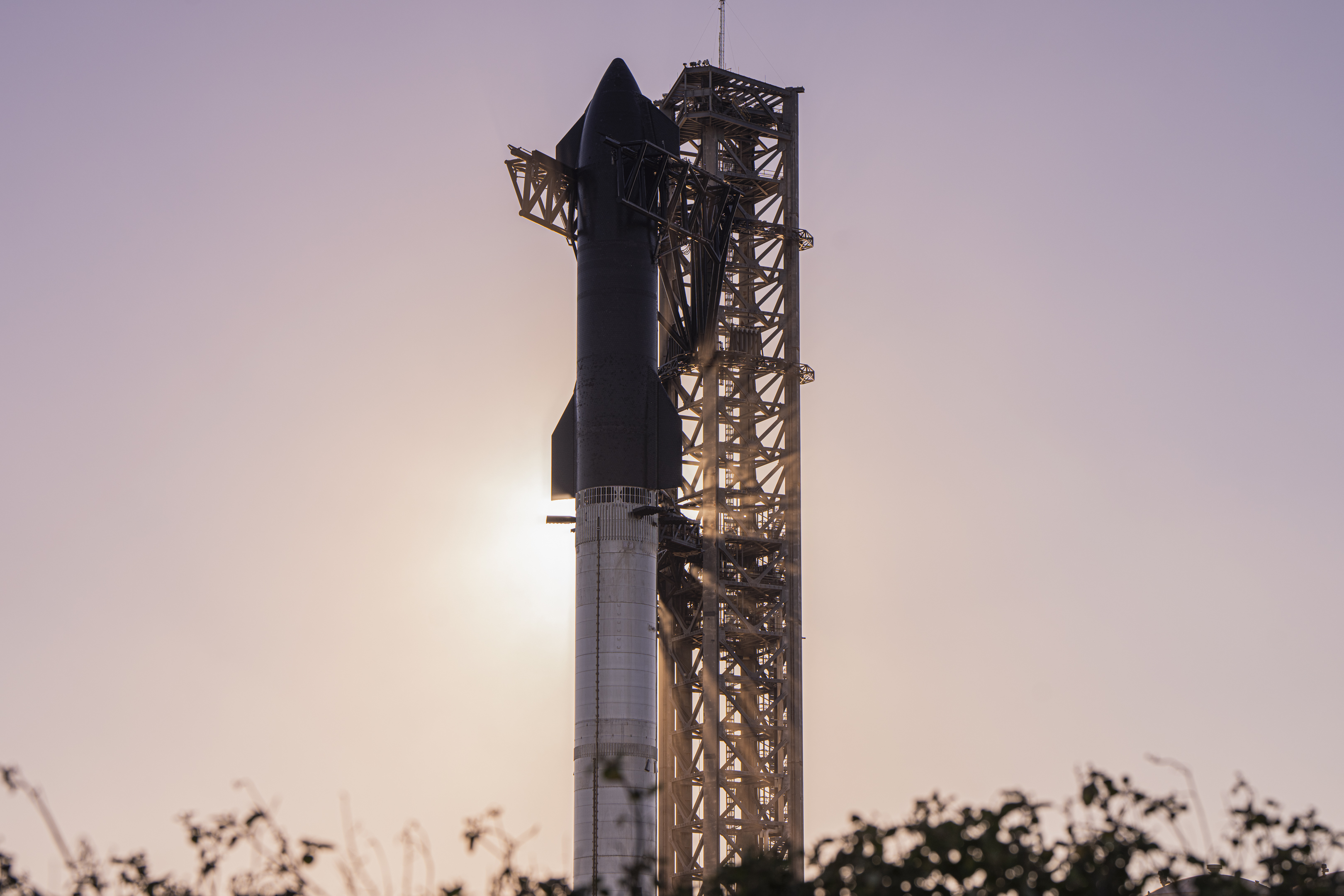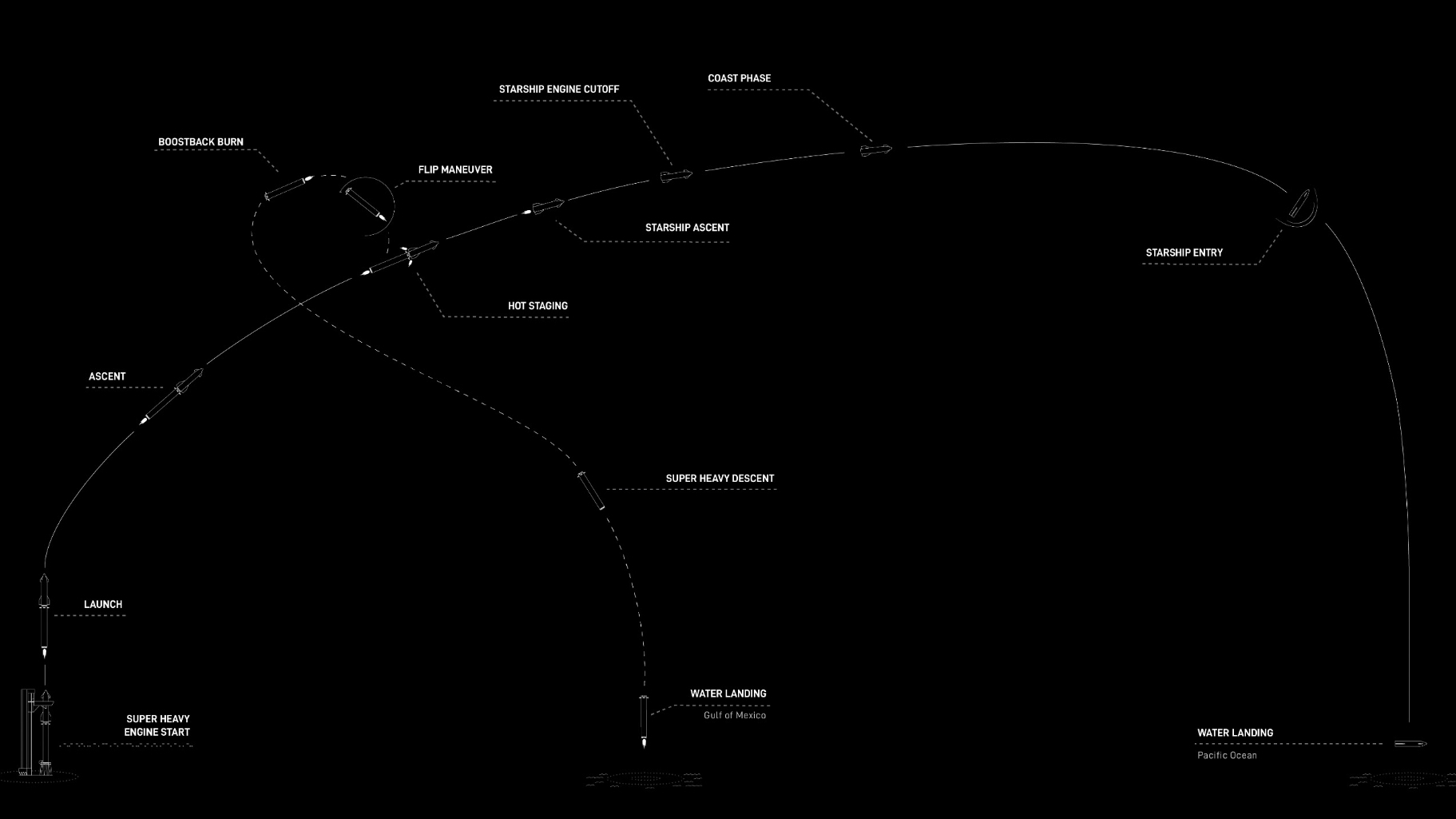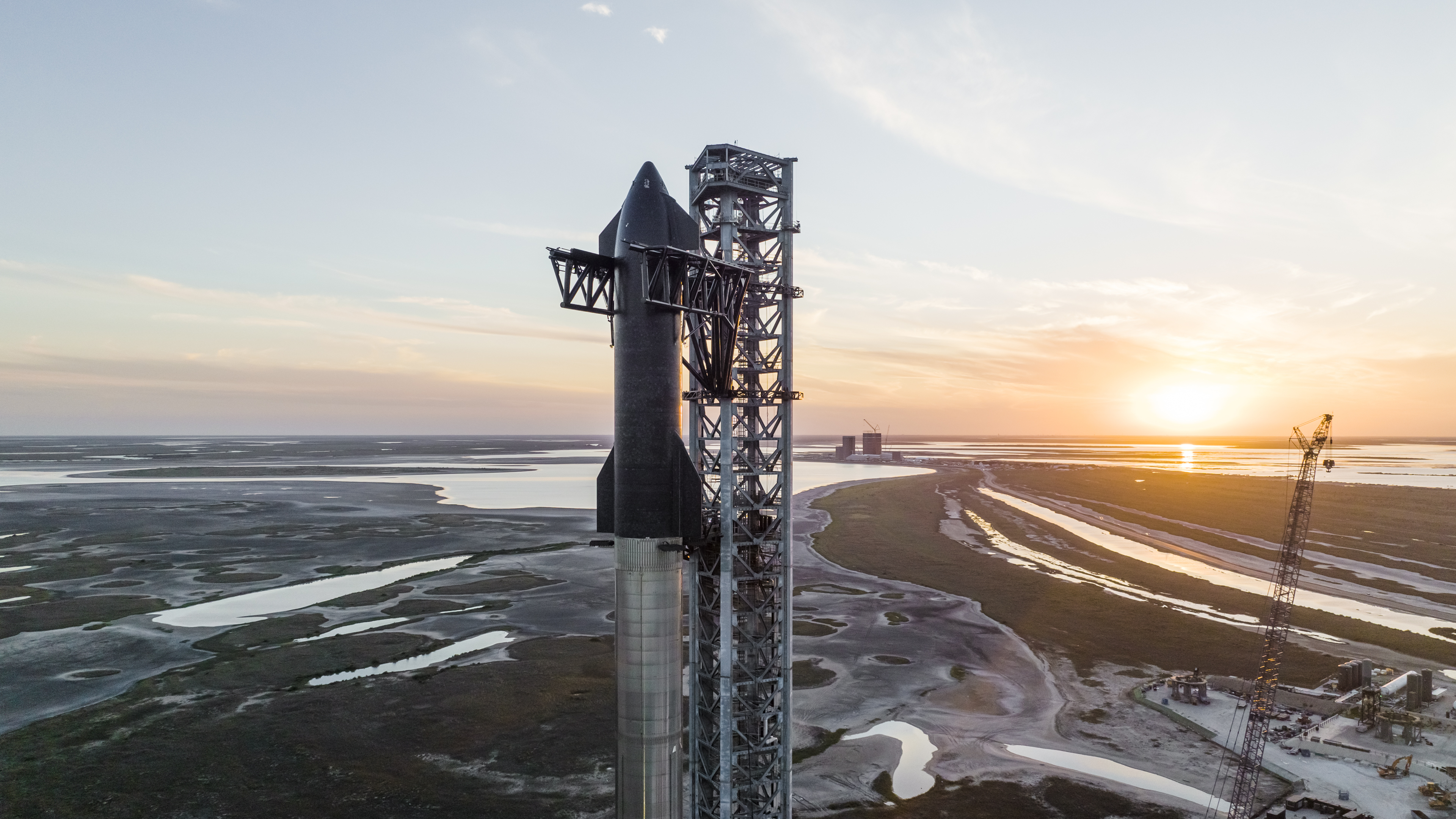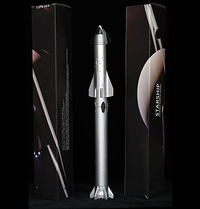What time is SpaceX's 2nd Starship and Super Heavy launch today (Nov. 18)?
Liftoff is scheduled to occur during a two-hour window that opens at 8 a.m. EST (1300 GMT).
Update for Nov. 18: SpaceX launched its Starship rocket and Super Heavy booster on its second flight test, but the vehicles exploded during flight. Read our coverage for full details and video.
It's been nearly seven months since SpaceX's first Starship megarocket exploded in a brilliant fireball over South Texas in a failed launch test, but the company is ready to try again. If you're hoping to watch SpaceX's second Starship test flight, you'll need to know when to tune in, and for that, we've got you covered.
SpaceX's second Starship and Super Heavy booster test flight is currently scheduled to launch from the company's Starbase site near Boca Chica, Texas no earlier than Saturday, Nov. 18, at 8 a.m. EST (1300 GMT). It will be 7 a.m. local time at liftoff time. The launch was originally set for Nov. 17, but SpaceX delayed it by 24 hours to replace a grid fin actuator on the launch stack.
Standing 395 feet tall (120 meters) tall, Starship is the world's tallest and most powerful rocket, and it's designed to be fully reusable for SpaceX missions to deep space. NASA has picked Starship to land its Artemis 3 astronauts on the moon in 2025. But first, SpaceX has to prove Starship is ready for orbital flight, which is where this test comes in. It remains to be seen if SpaceX will target the 8 a.m. EST start time or aim for sometime within its launch window. Here's what we know about what time the mission will fly.
Related: How to watch SpaceX's 2nd Starship launch on Nov. 18
More: How SpaceX's 2nd Starship rocket test launch will work
What time is SpaceX's 2nd Starship launch?

Currently, SpaceX is targeting Nov. 18 at 8 a.m. EST (7 a.m. CST/1300 GMT) to launch Starship's second test flight, but the launch could happen anytime within a 20-minute window that closes at 8:20 a.m. EST (7:20 a.m. CST/1320 GMT), SpaceX has said. The company's Nov. 17 launch window was longer, running 2 hours.
SpaceX launched its first Starship on April 20, but the rocket was intentionally exploded after its stages failed to separate as planned. The 33 engines of the Super Heavy first stage carved a huge crater beneath its launch mount, which SpaceX spent months repairing and upgrading.
Get the Space.com Newsletter
Breaking space news, the latest updates on rocket launches, skywatching events and more!
SpaceX has since installed a water deluge system beneath the launch pad to avoid such damage on this launch. The company also shifted to a hot-staging technique for stage separation, in which the upper Starship stage begins firing its engines before separating from the Super Heavy, for this launch.
"This is another chance to put Starship in a true flight environment, maximizing how much we learn," SpaceX wrote in a Nov. 16 update on X, formerly known as Twitter.
According to an updated mission overview, Starship's "Second Flight Test" (as SpaceX calls it) will lift off within a 20-minute launch window that runs from 8:20 a.m. EST. The conditions of Starship, its Super Heavy booster, the weather and any ships in an offshore "keep-out" zone in the Gulf of Mexico could affect the launch time.
"As is the case with all developmental testing, the schedule is dynamic and likely to change, so be sure to stay tuned to our X account for updates," SpaceX wrote in the mission overview.
Starship Die Cast Rocket Model Now $69.99 on Amazon.
If you can't see SpaceX's Starship in person, you can score a model of your own. Standing at 13.77 inches (35 cm), this is a 1:375 ratio of SpaceX's Starship as a desktop model. The materials here are alloy steel and it weighs just 225g.
Note: Stock is low so you'll have to act quickly to get this.
Can I watch the 2nd SpaceX Starship launch?
Yes, you'll definitely be able to watch SpaceX's second Starship launch online.
SpaceX has said it will provide a live webcast of the Starship launch, beginning about 30 minutes before liftoff, on its X account. The webcast will also be carried by Space.com and will be embedded at the top of this page. It is currently expected to begin at 7:30 a.m. EST (1230 GMT) ahead of an 8 a.m. EST liftoff.
IMPORTANT NOTE: As SpaceX has said, the start time could change, potentially moving deeper into the window.
Several other SpaceX-watching publications and websites will offer wider commentary with their own livestream services. One site we like to follow is NASASpaceflight.com, which offers regular livestreams of Starship testing activities at the Starbase facility. NSF will have extensive YouTube livestream coverage, likely beginning in the hours before SpaceX's own webcast.
In the past, SpaceX has offered live YouTube webcasts and audio channel livestreams of its Starship tests and Falcon 9 or Falcon Heavy launches. However, the company has shifted to X for the bulk of its recent launches.
If the company does add a YouTube livestream, we'll be sure to add that here once it does so.
If you are in the Boca Chica area and hoping to view the launch, there are several options.
While there is no official SpaceX viewing site, there are several public beach areas from which you can see the launch. The nearby South Padre Island offers clear views of the rocket from the shoreline around Cameron County Amphitheater and Isla Blanca Park. Similar viewing areas can be found around the nearby shore of Port Isabel and the surrounding areas.
Whereever you opt to view the launch from, plan to arrive early and bring water, sunscreen and bug spray if you're outside.
How long is SpaceX's 2nd Starship flight?

Like the first Starship test flight (which admittedly ended much earlier than planned), SpaceX's Second Flight Test is expected to last about 90 minutes if all goes according to plan.
Starship is not expected to enter orbit on this flight, but should reach a top speed close to orbital velocity (which is around 17,000 mph, or 27,400 kph). It will send the Starship vehicle on a path to splash down off the coast of Hawaii, while the Super Heavy booster attempts a water landing in the Gulf of Mexico.
The first Starship flight targeted an altitude of about 146 miles (234 kilometers) and a flight path that aimed for a splashdown in the Pacific Ocean about 140 miles (225 km) from the coast of Oahu, Hawaii. The Super Heavy booster's path aimed for a soft landing and splashdown in the Gulf about 20 miles (32 km) from Boca Chica Beach. It's uncertain if SpaceX is targeting those same parameters for this second flight, but the company has released a rough schedule for the mission.
| TIME (Hr:Min:Sec) | EVENT | Header Cell - Column 2 |
|---|---|---|
| T-2:00:00 | Flight director poll for fuel loading | Row 0 - Cell 2 |
| T-1:37:00 | Super Heavy liquid oxygen loading begins | Row 1 - Cell 2 |
| T-1:37:00 | Super Heavy liquid methane loading begins | Row 2 - Cell 2 |
| T-1:17:00 | Starship liquid methane loading begins | Row 3 - Cell 2 |
| T-1:13:00 | Starship liquid oxygen loading begins | Row 4 - Cell 2 |
| T-00:19:40 | Super Heavy Raptor engine chilldown | Row 5 - Cell 2 |
| T-00:00:10 | Flame detector activation | Row 6 - Cell 2 |
| T-00:00:03 | Raptor ignition sequence startup | Row 7 - Cell 2 |
| T-00:00:00 | Liftoff ("Excitement Guaranteed," as SpaceX puts it.) | Row 8 - Cell 2 |
| TIME (Hr:Min:Sec) | FLIGHT EVENT | Header Cell - Column 2 |
|---|---|---|
| T+00:02 | Liftoff | Row 0 - Cell 2 |
| T+00:52 | Starship/Super Heavy reach Max Q | Row 1 - Cell 2 |
| T+2:39 | Super Heavy main engine cutoff | Row 2 - Cell 2 |
| T+2:41 | Hot-staging separation/Starship Raptor engine ignition | Row 3 - Cell 2 |
| T+2:53 | Super Heavy boostback burn startup | Row 4 - Cell 2 |
| T+3:47 | Super Heavy boostback burn engine shutdown | Row 5 - Cell 2 |
| T+6:18 | Super Heavy is transonic | Row 6 - Cell 2 |
| T+6:30 | Super Heavy landing burn | Row 7 - Cell 2 |
| T+6:48 | Super Heavy landing burn shutdown | Row 8 - Cell 2 |
| T+8:33 | Starship engine cutoff | Row 9 - Cell 2 |
| T+1:17:21 | Starship reentry | Row 10 - Cell 2 |
| T+1:28:43 | Starship is transonic | Row 11 - Cell 2 |
| T+1:30:00 | Starship splashdown | Row 12 - Cell 2 |
What if Starship can't launch?

Since SpaceX couldn't launch its second Starship test flight on Nov. 17 as planned, the company is aiming for a Nov. 18 target and could try again relatively soon, depending on the nature of the scrub.
Officials with Cameron County, the Texas county that includes SpaceX's Starbase facility at Boca Chica beach, have released a beach closure advisory that suggested that SpaceX had set aside Nov. 18 and Nov. 19 as potential backup dates for the launch, one of which SpaceX now plans to use.
But Starship and Super Heavy require massive amounts of propellant. If SpaceX fully fuels the towering vehicles, then scrubs the launch, that could potentially cause additional down time as the company works to secure more liquid oxygen and liquid methane propellant for the next attempt. SpaceX has said it can take several days to resupply its propellant depot for a Starship launch.
Of course, a malfunction or technical glitch during the launch countdown — or an unexplained abort — could cause a more lengthy delay for Starship.
Editor's note: Tune in to Space.com on Saturday, Nov. 18 to watch SpaceX's second Starship launch at 8 a.m. EST (1300 GMT). The live webcast is expected to start at 7:30 a.m. EST (1230 GMT).
This story was updated at 2:45 pm ET to include the new launch date for SpaceX's Starship Second Test Flight due to a 24-hour delay.
Join our Space Forums to keep talking space on the latest missions, night sky and more! And if you have a news tip, correction or comment, let us know at: community@space.com.

Tariq is the Editor-in-Chief of Space.com and joined the team in 2001, first as an intern and staff writer, and later as an editor. He covers human spaceflight, exploration and space science, as well as skywatching and entertainment. He became Space.com's Managing Editor in 2009 and Editor-in-Chief in 2019. Before joining Space.com, Tariq was a staff reporter for The Los Angeles Times covering education and city beats in La Habra, Fullerton and Huntington Beach. In October 2022, Tariq received the Harry Kolcum Award for excellence in space reporting from the National Space Club Florida Committee. He is also an Eagle Scout (yes, he has the Space Exploration merit badge) and went to Space Camp four times as a kid and a fifth time as an adult. He has journalism degrees from the University of Southern California and New York University. You can find Tariq at Space.com and as the co-host to the This Week In Space podcast with space historian Rod Pyle on the TWiT network. To see his latest project, you can follow Tariq on Twitter @tariqjmalik.










